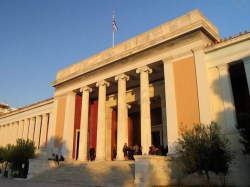Building of National Archaeological Museum

Building of National Archaeological Museum
The necessity of a National Museum was identified not only by the need for a historical-archaeological reappraisal but also by the strengthening of the Greek identity, which had suffered after 400 years of Ottoman occupation. In 1856, King Otto ordered the construction of the National Museum, for which he found a Greek from St. Petersburg, Dimitrios Bernardakis, as a generous donor.
The German architect Ludwig Lange, the then director of the Royal Academy of Arts in Munich, was initially commissioned with the construction. The plans were completed but the building project failed because it became more expensive than initially planned.
Only ten years later, in 1866, was the financing clarified and construction could begin. Panagiotis Kalkos took over the management, but he died prematurely. The then proposed architect and builder Theophillus Hansen refused to build according to Ludwig Lange's plans. Instead, his colleague Ernst Ziller took over the project and gave the museum its distinctive classicist façade, which makes the museum building so special. In 1874, the main building was finally inaugurated, and a few years later the side wings of the National Archaeological Museum. During the Second World War, the museum was closed from 1940 to 1945 and the exhibits were buried in boxes in secret places to protect them from looting.
Today, the National Archaeological Museum in Athens is considered the most important and complete museum in the world containing works of art and everyday objects of Greek antiquity. In a total of 52 rooms, more than 11,000 objects from all regions of Greece and different eras are exhibited in an exhibition area of approximately 24,000 square meters. The museum also has a 120-year-old library of archaeology with about 20,000 titles, including from the 17th century. In 2008, the Alexandros Onassis Foundation financed a comprehensive renovation of the library.








